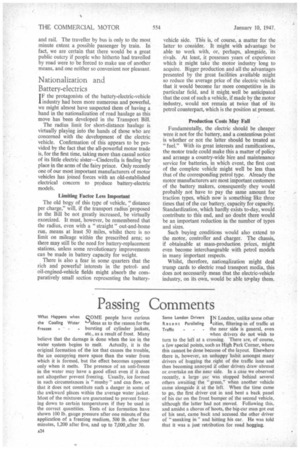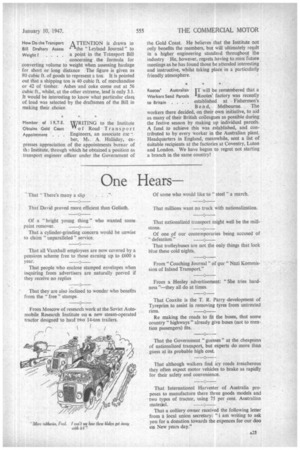Passing Comments
Page 26

Page 27

If you've noticed an error in this article please click here to report it so we can fix it.
What Happens when SOME people have curious the Cooling Water ideas as to the reason for the Freezes bursting of cylinder jackets, etc., as a result of frost. Many believe that the damage is done when the ice in the water system begins to melt. Actually, it is the original formation of the ice that causes the trouble, the ice occupying more space than the water from which it is formed, but the effect becomes apparent only when it melts. The presence of an anti-freeze in the water may have a good effect even if it does not altogether prevent freezing. Usually, ice formed in such circumstances is " mushy " and can flow, so that it does not constitute such a danger in some of the awkward places within the average water jacket. Most of the mixtures are guaranteed to prevent freezing down to certain temperatures if they be used in the correct quantities. Tests of ice formation have shown 100 lb. gauge pressure after one minute of the application of a freezing medium, 500 lb. after four minutes, 1,200 after five, and up to 7,000,after 30. Some London Drivers IN London, unlike some other Resent Paralleling 'cities, filtering-in of traffic at Traffic . . . the near side is general, even when drivers do not wish to turn to the left at a crossing. There are, of course, a few special points, such as High Park Corner, where this cannot be done because of the layout. Elsewhere there is, however, an unhappy habit amongst many drivers of hugging the right of the traffic lane and then becoming annoyed if other drivers draw abreast or overtake on the near side. In a case we observed recently, a large car was stopped behind several others awaiting the "green," when another vehicle came alongside it at the left. When the time came to go, the first driver cut in and bent a back panel of his car on the front bumper of the second vehicle, although the latter had not moved. Following this, and amidst a chorus of hoots, the big-car man got out of his seat, came back and accused the other driver of "sneaking in" and hitting his car. He was told that it was a just retribution for road hogging. How Do the Transportr-k TTENTION is drawn in Bill Drafters Assess the "Leyland Journal" to Weight 1 • . • a point in the Transport Bill concerning the formula for converting volume to weight when assessing haulage for short or long distance The figure is given as $O cubic ft. of goods to represent a ton. It is pointed out that a shipping ton is 40 cubic ft. of merchandise or 42 of timber. Ashes and coke come out at 56 cubic ft., whilst, at the other extreme, lead is only 3.1. It would be interesting to know what particular class of. load was selected by the draftsmen of the Bill in making their choice Member of I R.T.E. WRITING to the Institute Obtains Gold Coast "of Road Transport Appointment . . Engineers, an associate me ber, MI. A. Halliday, expresses appreciation of the appointments bureat: of th.: Institute, through which he obtained a position as transport engineer officer under the Government of the Gold Coast. He believes that the Institute not only benefits the members, but will ultimately result in a higher engineering standard throughout the industry He, however, regrets having to miss future meetings as he has found those he attended interesting and instructive, whilst taking place in a particularly friendly atmosphere.
Rootes' IT will be remembered that a Workers Send Parcels 1Rootes' factory was recently to Britain . . . . established at Fishermen's B end, Melbourne. The workers there decided, on their own initiative, to aid as many of their British colleagues as possible during the festive season by making up individual parcels. A fund to achieve this was established, and contributed to by every worker in the Australian plant. Headquarters in England, meanwhile, sent a list of Suitable recipients at the factories at Coventry, Luton and London. We have begun to regret not starting a branch in the same country!
Australian




















































































